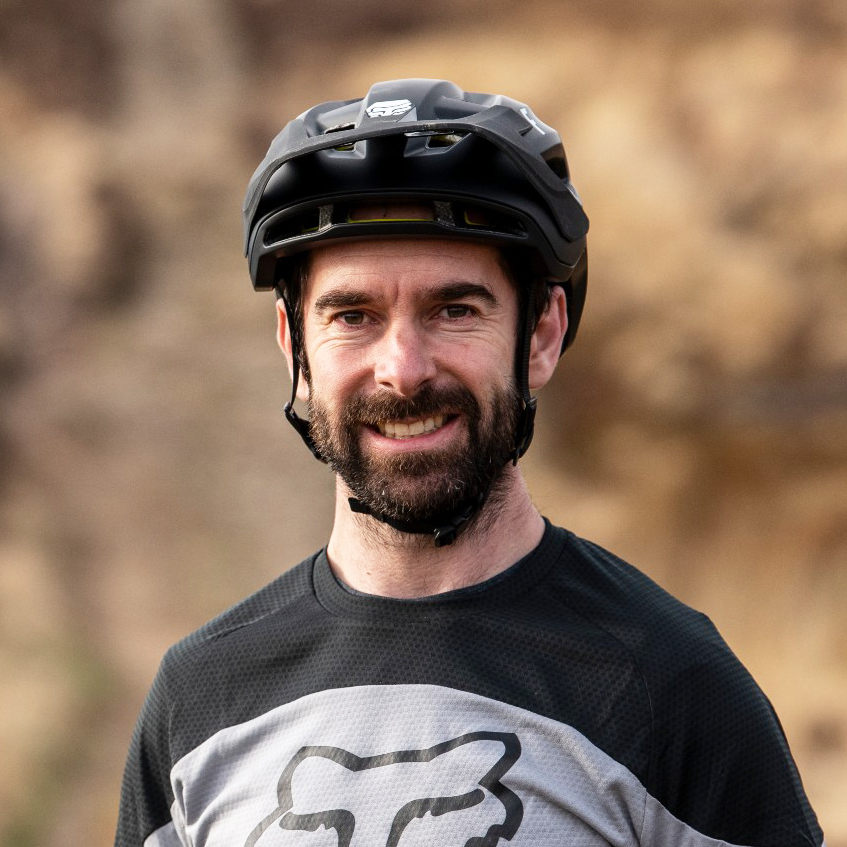As the door slid open on the soon-to-be-retired, slightly battered Whyte Bikes van, collective eyebrows were raised and an eagerness to ride soon rippled through all the journalists standing nearby. The new T-130 C sports some seriously clean, lustworthy lines, well-considered, hard hitting geometry and an impressive spec that really packs a punch.
End-to-end rigidity with even longer and slacker geo
Whyte went through four carbon prototypes before settling on the final production frame. The new carbon T-130 chassis consists of a ‘unidirectional multi-monocoque’ front triangle, which is claimed to be 11 percent stiffer than its alloy counterpart, and a symmetrical alloy rear triangle. The carbon makeover didn’t just boost frame stiffness though; Whyte also claims it's managed to save an impressive 580g over the equivalent alloy frame.

The wide lower pivot and bulbous bottom bracket area means there's plenty of stiffness when you put the power down
Importantly, the frame is designed around one chainring – just as we saw on other alloy Whytes last year – and has no provision for a front derailleur whatsoever. This in part allows for a broader and therefore stiffer main pivot just behind the bottom bracket, which is certainly noticeable when you stamp on the pedals.
The rear axle spacing has been given the Boost treatment, and now measures in at 148mm, bolstering stiffness even further. Whyte actually claims stiffness in the rear triangle has increased by six percent.
Whyte is famed for its bikes' radical geometry, and Ian Alexander, the man behind the drawing board has said the new T-130Cs have been effectively ‘upsized’ for 2016, and are now longer and slacker. The 67-degree head angle, low 331mm bottom bracket height and 449mm reach (on the medium) certainly give a nod to the Whyte’s intentions on the trail. The effective top tube has grown too and now measures in at just over 611mm on the medium frame.

Whyte's new T-130C is longer, lower and slacker than the current 2015 alloy counterpart
As the name suggests, the T-130 delivers 130mm (5.1in) of travel via its four-bar suspension design, which hasn’t been altered for 2016. There’s enough progression to allow for more aggressive riding and the easy access shocks available (RockShox Monarch RT3 DebonAir or Fox Float DPS Factory) can be tweaked using volume spacers to allow riders to really tailor feel.
There are two carbon complete bikes available (along with a further three alloy bikes).
- The more affordable T-130C RS is equipped with a RockShox Pike RC 130mm travel fork, RockShox Monarch RT3 DebonAir shock and SRAM’s X1/X01 transmission for £3,499 / $TBC / AU$TBC.
- Up the price by a grand and you’ll get the T-130C Works which comes complete with a Fox Float 34 Factory 130mm fork, Fox Float DPS Factory rear shock and a Shimano Deore XT 11-speed transmission with a Race Face Next carbon crankset for £4,499 / $5,499 / AU$TBC.
Shorter riders should note that there's no small frame size, just medium, large and extra-large. Our medium T-130C Works bike tipped the scales at 13.1kg (28.95lbs).
Short on travel, long on confidence
It’s fair to say that the T-130C is up against some seriously stiff competition in its category, including the Santa Cruz 5010 and the Transition Scout to name just a couple. Fortunately, even the very limited amount of saddle time we've had on the Whyte so far indicated that it can more than hold its head high in such company.
Related: Santa Cruz 5010 C – first ride
On our local jump infested, root riddled technical local trails in the Forest of Dean on the Welsh borders, the T-130C highlighted one thing clearly – this short-travel trail machine is ridiculously capable, comfortably tackling far more demanding terrain than you’d think possible.

The 130mm of rear wheel travel is controlled via the Fox Float DPS Factory rear shock on the Works model
It’s seriously sprightly and agile too. Punch at the pedals and things feel taut through the rear while you apply the power, making flatter trails and climbs feel far less of a chore. When things to start to get technical and steepen up, Whyte’s approach to geometry really helps elevate confidence levels and I never felt out of my depth, even when tackling some of more downhill focused trails on offer.
It’s a similar story when getting airborne too. The T-130C remains predictable and easy to manipulate as you launch from obstacle to obstacle and, thanks to that relatively low weight, picking it up and throwing it around the trail is easy is an easy and precise affair.
In the rough stuff, the suspension felt well balanced with more than enough support to really let us work the bike and load it into turns or pump it hard through trail undulations.

This stumpy little 50mm stem from Whyte has a broad bar clamp to help bolster stiffness
So, just how does it measure up against the other big names in its category? Well, it’s still early days for us, but there’s no denying that Whyte’s stretched out, slack and low geometry and its well-balanced suspension combine to create a special machine that doesn’t shy away from any trail, whether pointing up or down.
We’ve been lucky enough to hold onto this particular sample, so will get many more miles in before reporting back with a full review on BikeRadar very soon. Make sure you stay tuned!











